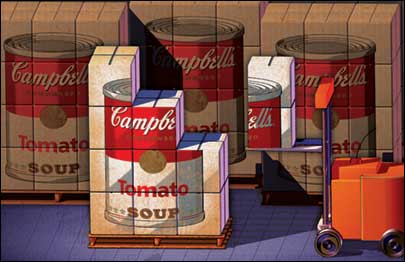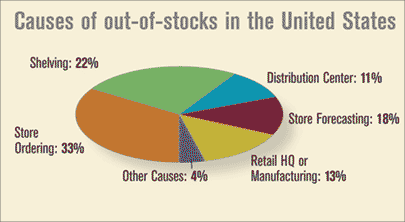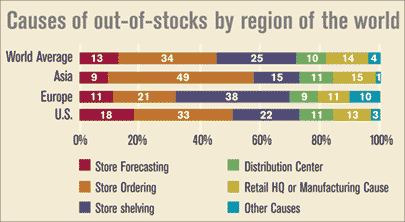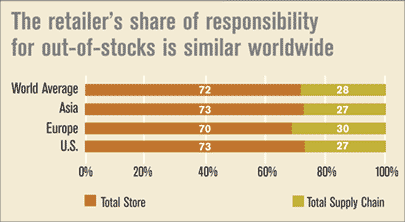Apr 01, 2005Over the past decade, retailers and their suppliers have spent hundreds of millions of dollars to reduce the number of times consumers can’t find the products they want on store shelves. They’ve invested in supply chain execution software and an alphabet soup of initiatives—CPFR (collaborative planning, forecasting and replenishment), ECR (efficient consumer response) and JMI (joint-managed inventory).
Despite these monumental efforts, the retail industry average for out-of-stocks remains a stubborn 8 percent globally. “For the top 100 retailers, that’s a $69 billion problem,” says Gerry Jastremski, director of retail availability at The Gillette Co.
What’s worse, the out-of-stock rate soars as high as 20 percent during special promotions, according to “Retail Out-of-Stocks: A Worldwide Examination of Extent, Causes and Consumer Responses,” a 2002 study commissioned by the Grocery Manufacturers of America (GMA). So while consumer product goods manufacturers and retailers spend the bulk of their advertising dollars on these promotions, consumers face a one in five chance of not finding the product when they get to the store.
“When faced with out-of-stocks, consumers delay their purchase, they brand swap or go to another store,” says Jastremski. “Whatever way you look at it, that’s bad news for the manufacturer and the retailer who see lost sales and a loss of consumer loyalty.”
Radio frequency identification has the potential to significantly reduce out-of-stocks by addressing inefficiencies in supply chains and providing real-time information about the location of goods. But RFID alone won’t solve the problem. Retailers will need to share data with suppliers so they can do a better job of forecasting demand. Both retailers and suppliers will need to change business processes—and their mindsets. They might even need to change the physical structure of their supply chains.
CPFR and other initiatives designed to better match supply and demand have had little impact on out-of-stocks, because they don’t attack the inefficiencies that contribute to the problem. They don’t, for instance, prevent late, missed or diverted deliveries; inventory miscounts; and misplaced stock. And they don’t provide real-time data about which products are out of stock and where replenishments are in the supply chain.
Retailers are responsible for nearly 75 percent of all out-of-stock situations, according to the GMA study. It says 50 percent of the time the problem stems from poor planning and forecasting by the retailer, and 25 percent of the time the products are within the store but are either misplaced or not recorded in store inventory systems.
Tackling supply chain problems
GMA members are manufacturers, so the study may have an unintended bias. But that doesn’t let retailers off the hook. One problem is retailers base the orders they place with suppliers on historical point-of-sale (POS) data. So when there’s a sudden spike in sales of bottled water because of a heat wave, the stores inundate their regional distribution center (DC) with orders. When the DC runs low, it places orders for more bottled water with suppliers. Even if suppliers have large safety stocks and react quickly, there’s still a delay in getting goods to the stores. With RFID data, manufacturers would see a sudden increase in shipments from the retailer’s DC to the stores and could react immediately.
To keep store shelves stocked, employees walk the aisles and add out-of-stock items to a “pick list”—a list of items that need to be brought out from the back room. Often no one sees an out-of-stock for days. And then some items can’t be located in the back room—even when inventory systems indicate several cases are in the store—so the items remain out of stock until a new shipment arrives.
These types of small inefficiencies add up and compound over time. RFID can help retailers tackle these problems in three ways. First, it can reduce human error by matching goods with purchase orders. Let’s say a store orders five cases of Gillette Venus razors, but an employee at the DC loads five cases of Mach3 razors on a pallet. Readers would scan the tags on those cases, and software would match what’s on the pallet with the purchase order and alert the person stacking the cases to the error.
The second way is to automate processes. When tagged cases arrive at DCs and stores, portal readers would automatically read the cases’ tags without slowing down processes or requiring a lot of manual labor. Companies would be able to collect more data, while reducing the errors that creep in when people are required to scan bar codes or type information into computer systems. Provided the RFID system is set up properly, this would reduce inventory inaccuracies.
The third way RFID helps retailers tackle out-of-stocks is by providing real-time, or near real-time, visibility. Knowing precisely where cases are in the store is critical, because it enables retailers to automate the process of creating pick lists and improve the way they replenish goods.
Wal-Mart has installed portal readers at the receiving doors of 140 stores and in doorways between the back room of these stores and the retail floor. When tagged cases arrive, Wal-Mart knows they are in the back room. When the cases are brought out from the back room, Wal-Mart knows they are on the store floor. And when case tags are read at the trash compactor, Wal-Mart can assume with a high degree of probability that the contents are on the shelf. (For more on Wal-Mart’s use of RFID, see Wal-Mart Tackles Out-of-Stocks.)
Manufacturers also have to shoulder some of the blame for out-of-stocks. RFID systems can help reduce the inefficiencies in their own supply chains, which contribute to the problem. By scanning pallets as they are built or as they are loaded on trucks, and matching the contents of a shipment against the retailer’s purchase order, manufacturers can limit the number of times they ship the wrong goods to retail stores or DCs. And by sharing demand signals with their own suppliers, manufacturers can make sure they have enough parts and materials to ramp up production to meet a sudden spike in demand from retailers.
Sharing data
In addition to solving their own internal problems, retailers and manufacturers need to share accurate information about where goods are in the supply chain. Today, many retailers share POS data with their suppliers so that manufacturers can forecast demand and set production schedules accordingly. But some retailers provide that data daily, others weekly and others monthly.
“There’s a need to rewrite software and forecasting systems so they don’t rely on POS data, which is inaccurate, or store ordering, which is too delayed,” says Hau Lee, a professor of operations, information and technology at Stanford University’s Graduate School of Business. “What’s needed is middleware that can capture what’s processed through the impact door using RFID and then send that data to planning systems. That’s the missing link.”
Lee is a cofounder of Menlo Park, Calif., startup Truth Software, which has developed an application called True Demand to try to tackle the out-of-stock issue. Retailers that have equipped their DCs and stores with RFID technology can use the application to provide manufacturers with information about what was shipped from a retail DC to specific stores and which cases were consumed at that store. True Demand is designed to provide manufacturers with near real-time information about what inventory is on hand in the store, so the manufacturer is better able to allocate inventory to fulfill the orders that come in.
By having visibility about where products are located and what inventory levels are in the stores, suppliers can also alert Wal-Mart to potential out-of-stocks before they occur. “If we know they need our products and that there’s a trailer loaded with cases of Conros products in their backyard, we can make sure they pay attention to it,” says Navin Chandaria, CEO at Conros, a manufacturer of synthetic fire logs that’s adding RFID labels to its Wal-Mart shipments.
Large manufacturers believe that greater visibility of their retailer partners’ inventory would provide another benefit. Manufacturers would no longer have to keep safety stocks on hand to meet demand, which would mean significant savings for them. “Manufacturers would love to see how much retailers and distribution companies have of their products sitting there to get a real sense of demand,” says Lyle Ginsburg, managing partner for technology innovation in Accenture’s global products operating group.
Forging a new relationship
Large retailers typically dictate what information they want from manufacturers and how they want it (some use electronic data interchange, others the Internet or extranets). The retailers also determine what information they will provide to suppliers and how often they will provide it. This creates problems for manufacturers. It’s costly to have different methods of sharing data, and they can’t fine-tune their production schedules equally for all customers.
The EPCglobal Network—a network that will enable EPCglobal subscribers to share EPC data over the Internet—could help to foster closer collaboration within the supply chain. The network is being designed and built by EPCglobal for the benefit of all supply chain players, so manufacturers will benefit from having a single means of sharing information with all their customers. And they will have some influence over what kind of data is collected and shared.
Even so, sharing EPC data will require not just an investment in technology, but a new mindset. Retailers and manufacturers are both partners and adversaries. Retailers want to get the lowest price for the goods they buy from suppliers, and suppliers want to get the highest price. This adversarial relationship can sometimes impede the need to collaborate on issues of common interest, including reducing out-of-stocks.
This closer cooperation needs to extend to the operation of individual stores. One reason so many promotion items are out of stock is because the retailer doesn’t always tell the manufacturer when it plans to run a promotion. And if it does tell the manufacturer, it doesn’t provide updates during the promotion. So the manufacturer doesn’t know whether to ship more goods or fewer. “Promotions are really a wild guess for manufacturers,” says Stanford’s Lee.
Changing the physical infrastructure
Even if retailers and manufacturers attack inefficiencies in their own operations, share more information and collaborate more effectively, that won’t completely solve the out-of-stock problem. Consider what happens if demand for a new toy or electronic gadget suddenly spikes. Retailers can share demand information and product movements, but it’s still going to take time to get more product into the supply chain if the goods are made in Asia.
The supply chains of North America, Europe and Asia each have their own characteristics that will make this last phase of the battle against out-of-stocks harder or easier. North American companies probably face the biggest challenges, because manufacturers, which in many cases are in another country, typically ship product to large DCs that, in turn, ship the goods to stores, which could be several hundred miles away. European manufacturers make more shipments directly to stores, and Asian retailers have networks of suppliers that enable them to source a large portion of their goods from local suppliers.
In North America, stores typically get deliveries on scheduled intervals, such as Mondays and Thursdays. But that doesn’t help if, using new RFID data, a retailer determines it will be out of, say, six-packs of Coca-Cola by Saturday afternoon. To respond to impending out-of-stocks, retailers and manufacturers will need to make their supply chains more flexible.
One option is to switch to daily deliveries based on what’s actually needed in the store. But with today’s hub-and-spoke setup—goods are shipped to a regional DC, then to all the stores in four or five states—this would be prohibitively expensive.
Another option is to reengineer the physical setup of the supply chain. Instead of shipping product to one large retail DC, manufacturers would send goods to smaller warehouses that are spread out across the region so they’re closer to stores, or to cross-docks, where large shipments are not put into inventory but are immediately broken down and put onto trucks bound for stores. “Seeing real-time information at a more granular level in the supply chain is going to drive the need for a more responsive supply chain with more cross-docking and more direct-to-store deliveries,” says Kevin Mitchell, associate partner in Accenture’s supply chain service.
Whatever model is adopted, it’s likely retailers will turn over the responsibility of ensuring product is always in the back of the store to the manufacturers. That’s because RFID data will give manufacturers the means and incentive (greater sales) to manage inventory for retailers, says Mitchell. It reduces the retailers’ headache of reordering and gives manufacturers greater control over what happens to their products in the supply chain. The manufacturers that operate most efficiently will have a huge competitive advantage.
Early RFID deployments in retail stores and supply chains show great promise, and the infrastructure needed to take advantage of the RFID data collected is being built out. But clearly, a great deal of work needs to be done to solve the $69 billion problem.
The ultimate goal of some retailers is to be able to track goods in the store in real time, by having “smart shelves”—shelves with RFI D readers—monitor inventory and warn of an impending out-of-stock before it occurs. Today, RFID tags are too expensive to be used on most individual consumer products, and RFID readers are too expensive to add to store shelves. But some retailers are experimenting with ways of using RFID to get real-time visibility of the shelves.
For more than a year, Tesco, the largest retailer in the United Kingdom, has been testing smart shelves that monitor DVDs in real time. At a DVD distribution company, tags are placed on DVDs bound for two stores. The DVDs are tracked both in the back of the store and on the shelf. The stores’ staff gets reports about which DVDs are out of stock and which are in the wrong shelf location, so workers can replenish the shelf and put items back in the right location. Tesco CIO Collin Cobain says that data obtained during the initial trial at the two stores indicates that the RFID-enabled shelf increases on-shelf availability by 50 percent.
Tesco is planning to shift from using 13.56 MHz technology to UHF. But UHF tags are harder to read because the radio waves bounce off the aluminum coating on DVDs. Cobain says that when those issues are resolved, Tesco will roll the smart-shelf technology out to 10 U.K. stores.
If item-level tagging for all products ever becomes feasible, it could virtually eliminate out-of-stocks by alerting employees in the store when stocks on the shelf get dangerously low. “The Wal-Mart mandate has put the focus on the case and pallet, and companies are researching that first,” says Elizabeth Strong, general manager of MeadWestvaco Intelligent Systems, which developed and deployed the smart-shelf offering for Tesco. “But tracing items has to be done from the manufacturer to the customer, and in retail that can only be achieved with tagging at the item level."




